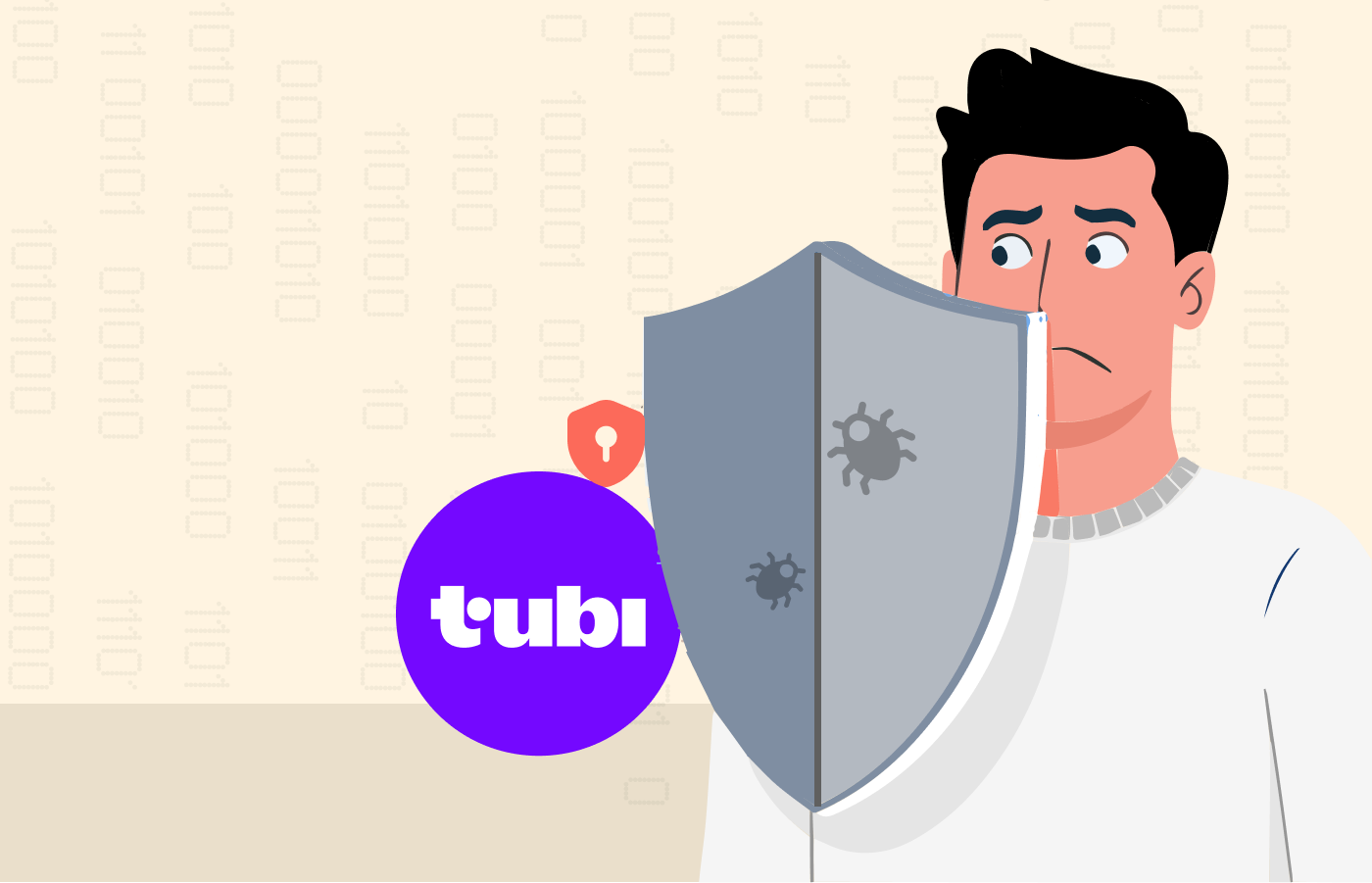Streaming is a convenient way to access your favorite entertainment media from the comfort of your home. Whether you want to catch up on your favorite movie or show, listen to your playlist, or watch a live event, streaming delivers whatever you need (and promptly).
But do you know how this happens? Streaming involves various technologies that transmit data packets over the internet, delivering high-quality visuals and audio you enjoy.
This article explains everything about streaming, how it works, its pros and cons, and more. Let’s explore.
What is streaming?
Streaming is how you watch and listen to media (video, audio, or live events) directly over the internet without having to download it. Instead of downloading the content file on your device, streaming delivers it in real time while you watch or listen.
For example, you watch movies or series on Netflix without downloading them. An audio content example would be Spotify where you listen to songs or podcasts without saving them on your device.
How does streaming work?
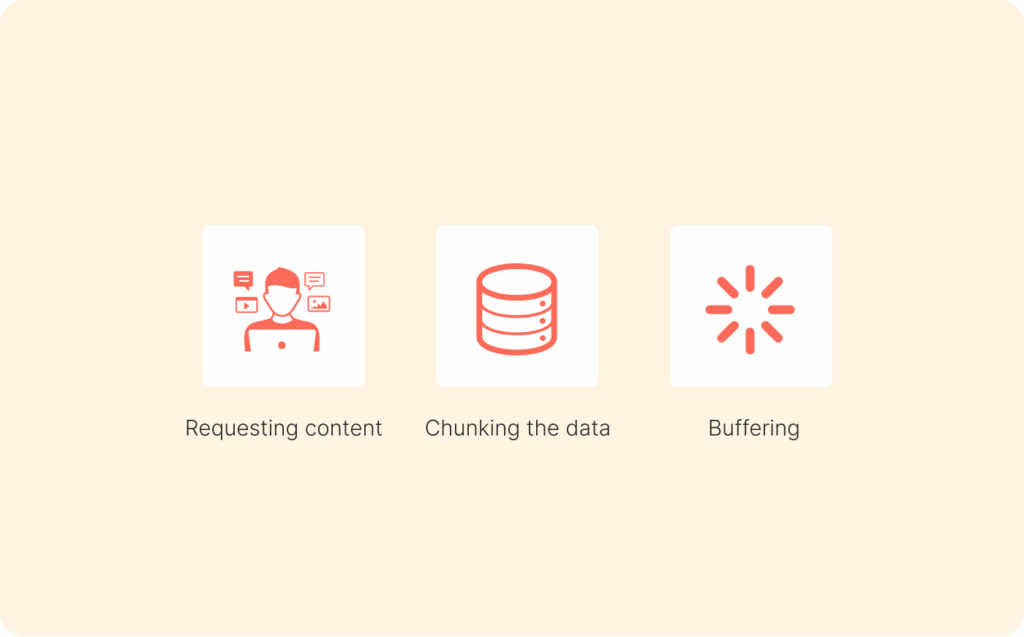
Here is a step-by-step process on how streaming works:
1. Requesting content
When start playing a video or music track, your device sends a request to the server that hosts the content. The server had the media file stored and is ready to dispense it as soon as you request it.
Chunking the data
Rather than sending the whole media file at once (which could take more time, storage, and consume internet), the server splits it into smaller pieces called “packets.” Each packet represents a small part of the video or audio (worth a few seconds), making the process faster and easier to manage.
2. Data transmission
After the server breaks down the data, it starts sending these packets to your device. These data packets travel across the internet through various protocols and networks to ensure they arrive at your device in the correct order and format.
3. Buffering
Your device doesn’t start playing the content with the first packets that arrive. Instead, it temporarily stores a few seconds of data in a buffer, which helps to keep playback smooth even if your internet briefly slows down.
Excessive buffering, however, isn’t the part of process, it happens due to multiple reasons that we’ve discussed in our guide here.
4. Decoding and playback
Once the buffer has enough data, the media player begins to decode the packets. Since these packets contain compressed data, your device uses encoding techniques (like AAC for audio or H.264 for audio) to decompress it back into the original format. As a result, the media starts playing smoothly through your speakers or on your screen.
5. Continuous data flow
As you stream, your device keeps sending requests for more data to the server. As the server sends the data packets, your device continually adds them to the buffer. The content will play smoothly as long as the buffer is full.
6. Adaptive bitrate streaming
Your streaming platform will adjust the quality of the stream to match your bandwidth (whether your internet connection slows down or speeds up). For example, if your internet connection slows down, the video bitrate quality might drop from HD to SD to prevent buffering and ensure the stream runs smoothly. Conversely, the stream will automatically switch to high quality if the connection improves.
7. Content delivery networks (CDNs)
Most platforms use content delivery networks (CDNs) to ensure the streaming process is faster and more efficient. These are servers spread across the world, close to the user. So, when you’re streaming something online, the data doesn’t always originate from the main server.
Instead, it comes from the nearest video CDN server, which shortens the distance the data travels, reducing buffering and making the streaming faster.
8. Streaming ends
Once you’re done watching or listening, the server stops sending data packets to your device. Any leftover packets in your buffer may be saved temporarily in your device’s cache. If you want to watch the same content again, the process starts over – but it might load faster because some data is still stored in the cache.
Types of content you can stream
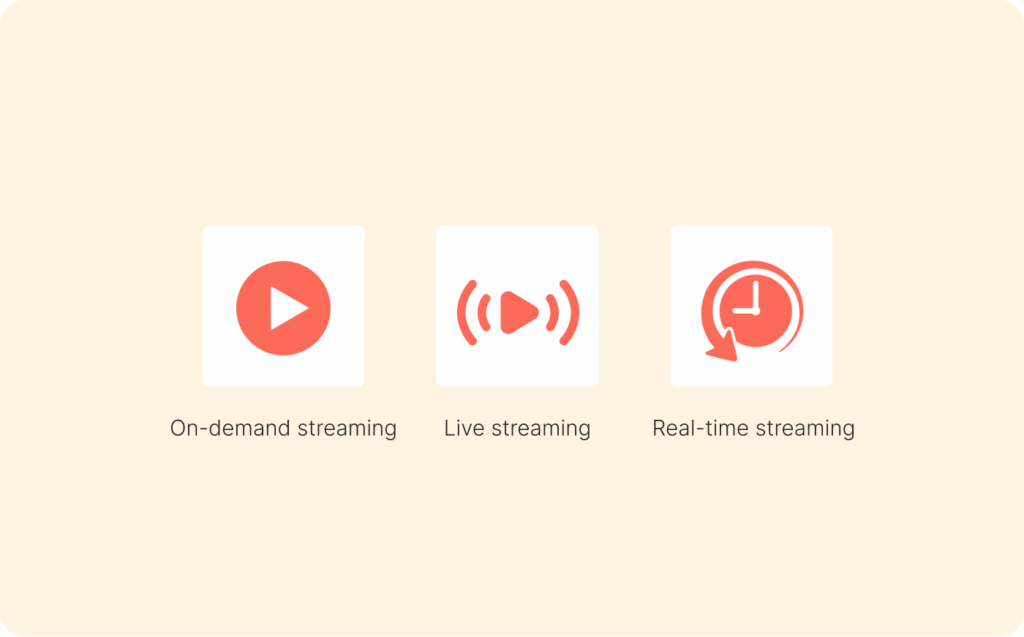
On-demand streaming
This is a method of streaming that allows you to access content at any time instead of waiting for a specific broadcast schedule. Platforms like Netflix offer video-on-demand (VOD) and Spotify provides audio-on-demand (AOD).
Live streaming
This involves watching live events as they unfold. Facebook Live and Twitch streaming are some of the common examples.
Real-time streaming
This involves ultra-low latency for the content to be transmitted almost instantaneously. Most conferencing software and multiplayer games use it.
Audio streaming
This involves music streaming, podcasts, radio, or other forms of audio media. Some of the common music streaming services include Spotify, Pandora Stream, and Apple Music.
Progressive streaming
This type of streaming allows you to download part of the file while you play it and it will eventually end up stored on your device.
Adaptive Bitrate Streaming (ABR)
This type of streaming automatically adjusts the quality of the stream depending on your internet speed to ensure a smooth experience.
Difference between streaming and downloading
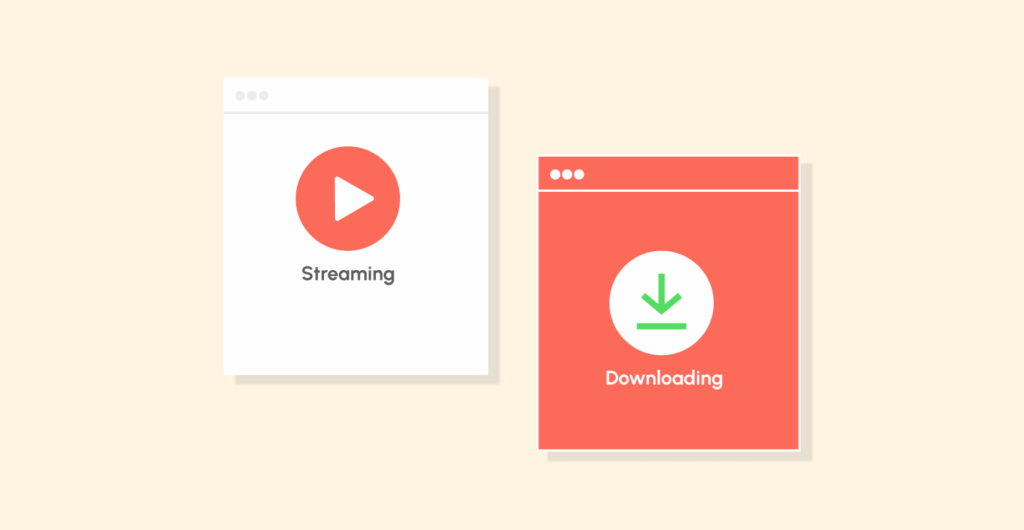
Streaming and downloading are two distinct methods of accessing digital media.
When streaming, you access media content in real-time over the internet without saving it on your device. You only need a stable internet connection to start streaming. After streaming ends, the content isn’t stored on your device and you must stream again to access it.
However, in downloading, you save the entire file on your device, enabling you to access it offline. Also, you need to wait for the full content to complete downloading before playing.
Here are the major differences:
| Feature | Streaming | Downloading |
|---|---|---|
| Access method | Plays media in real-time over the internet | Saves the entire file on your device |
| Internet requirement | Requires an active internet connection during playback | Only requires the internet to download, and then you can access the content offline afterward |
| Storage use | Minimal local storage (temporary cache) | Stores content permanently on your device until you delete it |
| Playback start time | Immediate or near-instant, once buffering begins | Delayed until the full file completes to download |
| File ownership | You don’t own the file and you can only access it temporarily | You have a copy stored locally on your device |
| Bandwidth usage | Continuous data use while playing | One-time data use during downloading |
Streaming advantages

Streaming is the main way most people consume entertainment nowadays. Here are some of the biggest benefits:
1. Prompt access
Unlike downloading, streaming allows you to start watching or listening almost instantly without waiting for the full file to download. You’ll start playing your favorite content as soon as you click on the file.
Instant access aligns with most people’s low tolerance for delays when it comes to consuming media. You don’t have to stay on a website if it takes long to load. Also, streaming allows you to watch your favorite content exactly when you want.
2. Saves your space
Streaming doesn’t consume space on your device. When downloading files, you have to ensure your device has sufficient storage space or you’ll have to start deleting files.
However, with streaming, there isn’t data saved on your device. Instead of saving the file locally, the data remains on a remote server, and you’ll simply access it as needed. This frees up valuable storage space for the files and media that matter most to you.
3. Schedules don’t have schedules
Unlike traditional entertainment that requires you to follow a specific broadcast schedule, streaming allows you to watch what you want, whenever you want.
However, you don’t have a schedule or wait for a specific time to enjoy your media. You can access the entire library of media content and enjoy it during your lunch break, after work or at the gym.
Streaming drawbacks
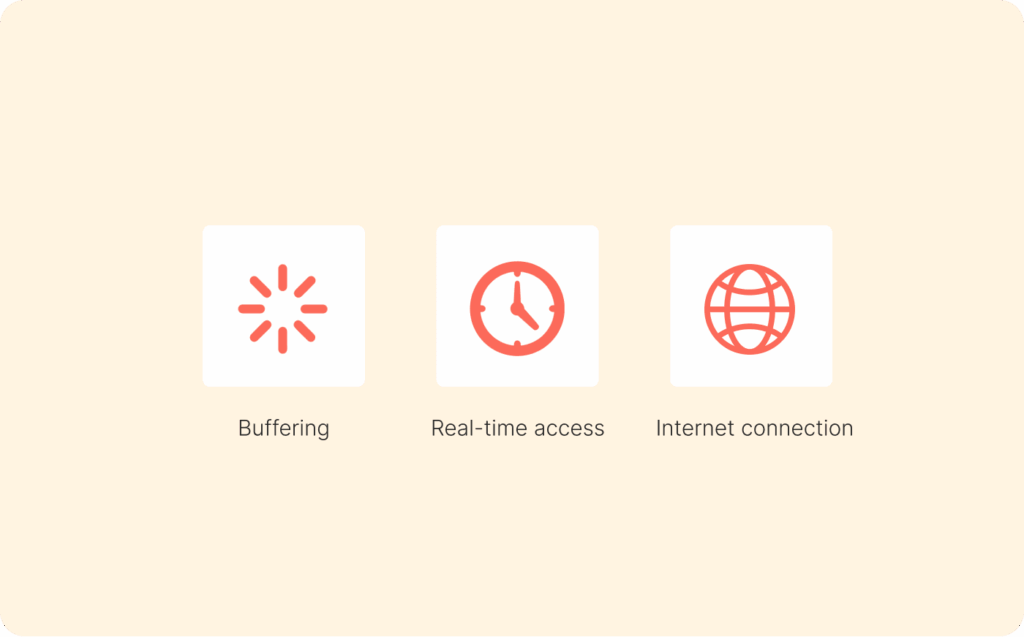
Despite the above benefits, here are some of the cons of streaming:
1. Buffering without a stable internet connection
Without a stable, high-speed internet connection, streaming media on your device can be difficult or even impossible. Streaming requires too high bandwidth and a low-performing internet connection can’t handle it.
Broadband is the baseline for smooth streaming, but higher speeds allow you to enjoy more content without any delays. Keep in mind that streaming over cellular data consumes significant bandwidth and could quickly exhaust your data allowance.
2. Real-time access
While downloading saves the media file locally on your device, streaming requires an active internet connection to access the content from its source.
If you want to watch the same stream again, you’ll need to revisit the source and ensure you have a reliable, high-speed internet connection. Without it, you won’t be able to access or play the content.
How to improve your streaming experience
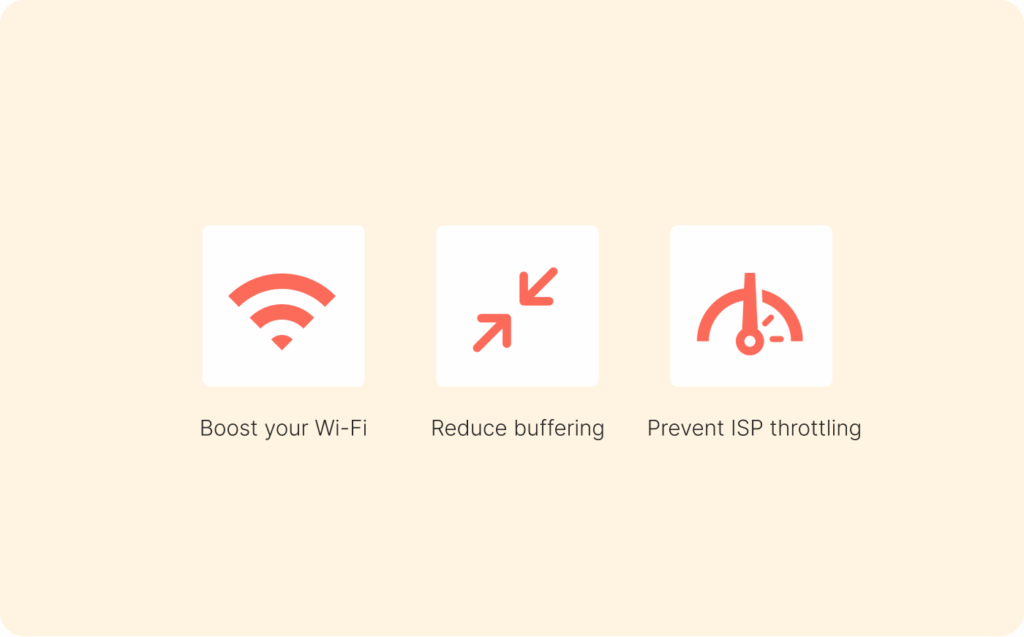
Here are some of the things you can do to improve your streaming experience:
- Boost your Wi-Fi: Streaming requires a fast enough internet connection. So, try improving your home Wi-Fi signal strength to enhance streaming speed and stability.
- Reduce buffering: Besides internet speed, you also need to reduce buffering while streaming.
- Unblock streaming options: Are your normal streaming options blocked when traveling? Use a VPN to unblock your favorite streaming platforms.
- Prevent ISP throttling: Your internet service provider (ISP) can throttle your speed if they detect excessive bandwidth usage. Use a VPN to prevent ISP throttling and stream smoothly.
- Avoid public Wi-Fi: While streaming during your airport layover may be convenient, using a public Wi-Fi network can be risky. So, always use a VPN to protect your connection when streaming on public Wi-Fi.
- Clean up your device: Your device might be struggling to stream because it’s cluttered with unnecessary files and other background data. Therefore, clean your device for better all-round performance.
- Ensure you have enough memory: Your device can struggle to stream content if it has insufficient random access memory (RAM). Therefore, upgrade your RAM to improve the streaming performance.
History of streaming
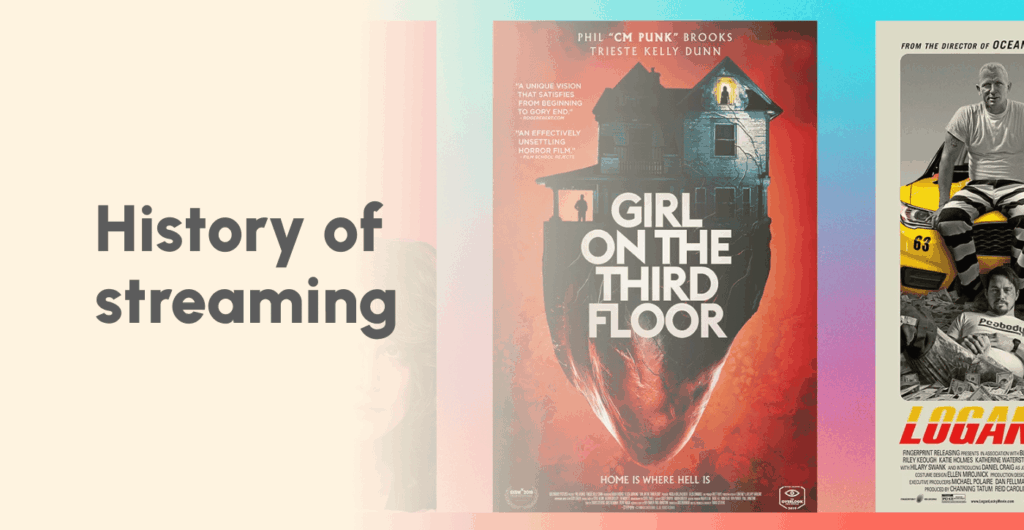
Streaming emerged in the 1990s as improvements in bandwidth and compression technologies made it possible to transmit media over the internet.
In 1995, RealNetworks pioneered audio streaming with the RealAudio software that enabled users to listen to live radio broadcasts online. Later on, RealVideo made video streaming possible, though the quality was much lower than what we have today.
Also, the rise of broadband internet in the 2000s revolutionized streaming. Also, video and audio streaming websites emerged around the same time, transforming how we access and enjoy movies, TV shows, and music.
The technology behind streaming
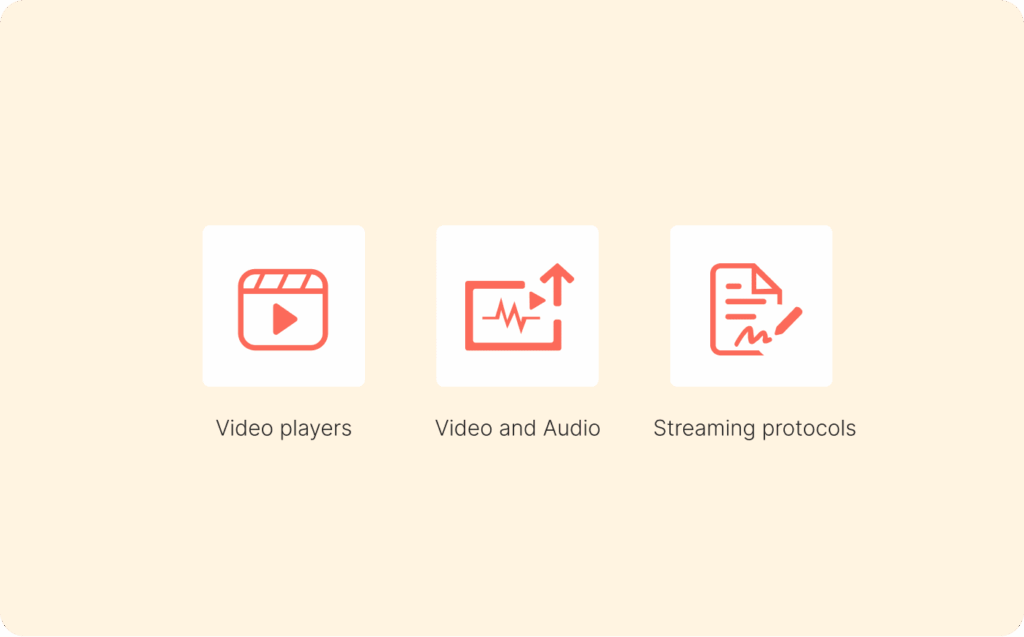
The entire streaming process involves different technologies that work together to ensure smooth playback and protection of media content. They include:
Video players
A video player is an application or software on your device that decodes and plays the content you’re streaming. It receives the stream from the server, decodes it using a codec, and displays it on your screen. The player also controls buffering and supports adaptive streaming to optimize quality based on your internet speed.
Video and audio compression (codecs)
Raw audio and video files are very large and it’s difficult to stream them as they are. Streaming platforms use compression techniques called codecs to shrink file sizes. Essentially, codecs takes raw media data, compress it for faster transmission and the media player decodes it for playback on your device.
Here are some of the common types:
- H.264/AVC: Most platforms including YouTube, Twitch, and Netflix, use this video codec because of its quality and compression efficiency.
- H.265/HEVC: This is a more advanced video codec that compresses data more efficiently, ideal for 4K content.
- VP9: An open-source video codec created by Google and widely used by YouTube.
- Advanced Audio Codec (AAC): A popular audio codec that provides great sound quality at lower bitrates.
Adaptive bitrate streaming (ABR)
This technology helps streaming platforms provide the best possible experience by adjusting the video quality based on internet speed.
While you’re streaming, the platform monitors your internet speed and automatically adjusts the video quality accordingly. This enables streaming platforms to ensure smooth playback regardless of your internet speed.
Streaming protocols
A streaming protocol is a set of rules that controls how media data is travels from a server to your device over the internet.
Here are some of the common streaming protocols:
- HTTP Live Streaming (HLS): It splits video into small pieces and adjusts the quality based on your internet speed.
- MPEG-DASH: This is a popular protocol for adaptive streaming that works with multiple codecs. Real-Time messaging protocol (RTMP): Adobe originally developed this protocol for Flash. Some platforms, like Twitch, use it during live streaming.
- Web real-time communication (WebRTC): It is used for real-time video streaming, like live gaming streams and video calls (Google Meet, Zoom).
Digital rights management (DRM)
DRM technology helps to protect digital content by restricting access and preventing unauthorized use, copying, or distribution. It ensures that only authorized users can unlock and watch the content, preventing illegal downloads or sharing.
Content delivery networks (CDNs)
CDNs are distributed servers strategically placed worldwide to deliver digital content closer to the user. They help to cut latency and improve load times because the data travels a shorter distance.
When you stream a video, you get it from the nearest server instead of the platform’s primary server. Some of the biggest CDN providers include Cloudflare, Akamai, and Amazon CloudFront.
Encoding and transcoding
Encoding shrinks raw video media files into a more manageable size for streaming while transcoding converts those files into different formats or quality levels.
Most streaming platforms use codecs to compress content into appropriate formats. Then, the video is transcoded into various resolutions.
Cloud infrastructure
Cloud storage and computing help streaming companies host massive media libraries and efficiently process and deliver content to users. These cloud systems automatically scale with demand, ensuring smooth performance even during traffic spikes.
How does live streaming work?
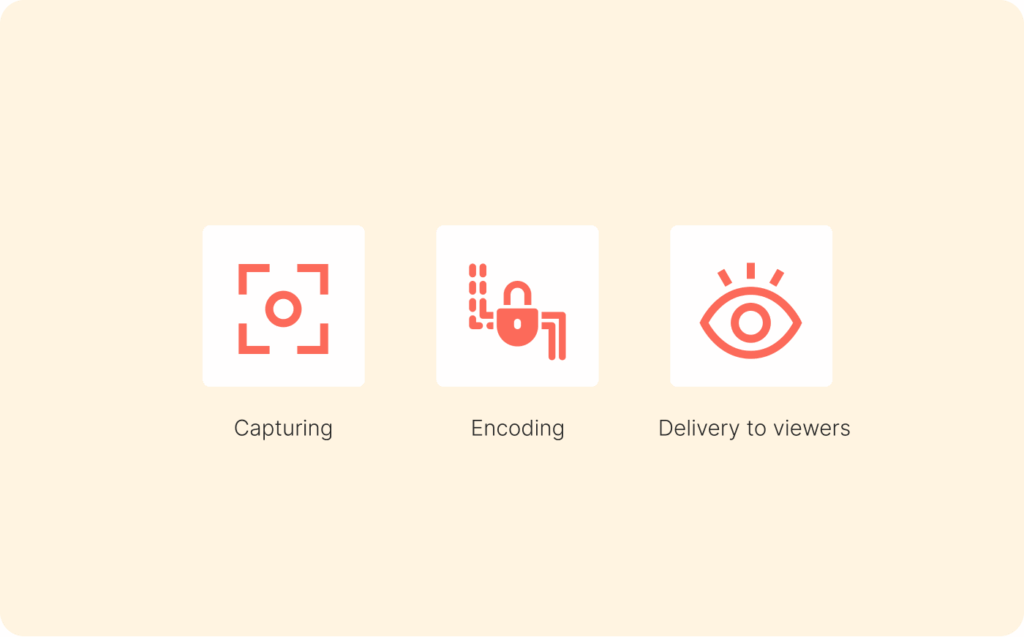
Live streaming is a type of streaming that offers content in real-time, allowing you to watch events as they unfold. It’s ideal for events like sports matches, concerts, social media broadcasts, and webinars.
Live streaming involves broadcasting an event in real time through the internet. Here are the steps it involves:
- Capturing: A camera captures events as they happen and feeds the raw video into a computer or streaming system for processing.
- Encoding: Since the raw video files are too large to transmit efficiently over the internet, they are compressed and encoded to shrink the file size.
- Streaming protocol: The encoded video is transmitted to a streaming server using protocols like real-time messaging protocol (RTMP). The server uses HLS or MPEG-DASH protocols to deliver the stream, ensuring it works seamlessly across various devices and web browsers.
- Delivery to viewers: The streaming server delivers the data to viewers in real time. Your devices decode and play the stream with minimal delay.
- Buffering and adaptive streaming: Live streaming platforms use buffering and adaptive bitrate streaming to ensure smooth playback.
Is free video streaming actually free?
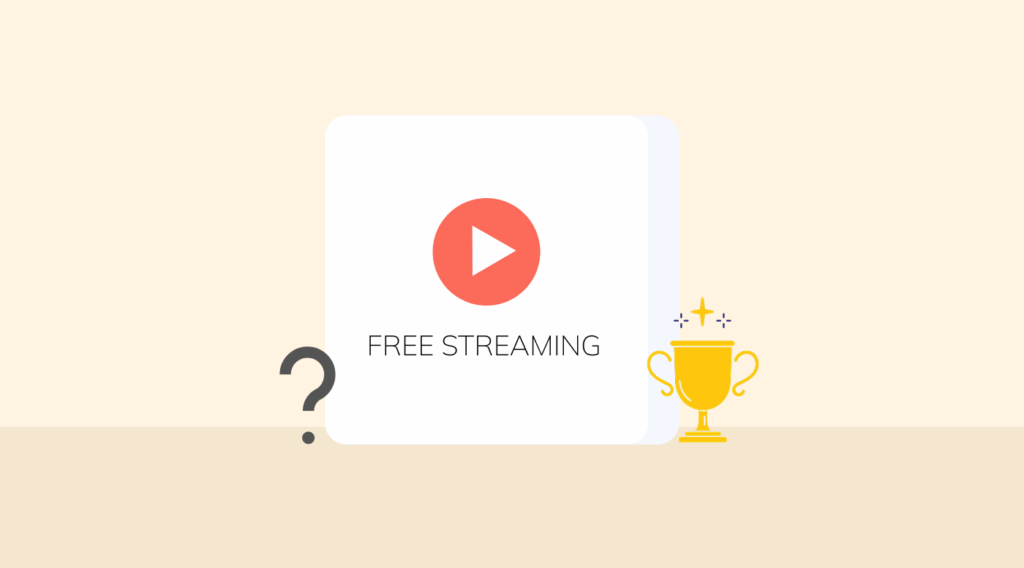
Free things often come with hidden strings attached. Since you don’t have to pay to access your favorite content on free streaming sites, they rely on displaying ads to generate revenue.
The way ads function differs from one service to another. For example, some platforms display markers on the playback interface indicating when ads will appear. You can generally expect ads to play at specific times, especially for on-demand content.
Thankfully, you can bypass ads on the platforms’ web versions by using a mix of ad-blockers and privacy extensions. However, you’ll have less luck blocking ads on ad-supported versions of some premium platforms. They require you to upgrade to higher tiers to remove the ads.
Is it legal to use a VPN for streaming?
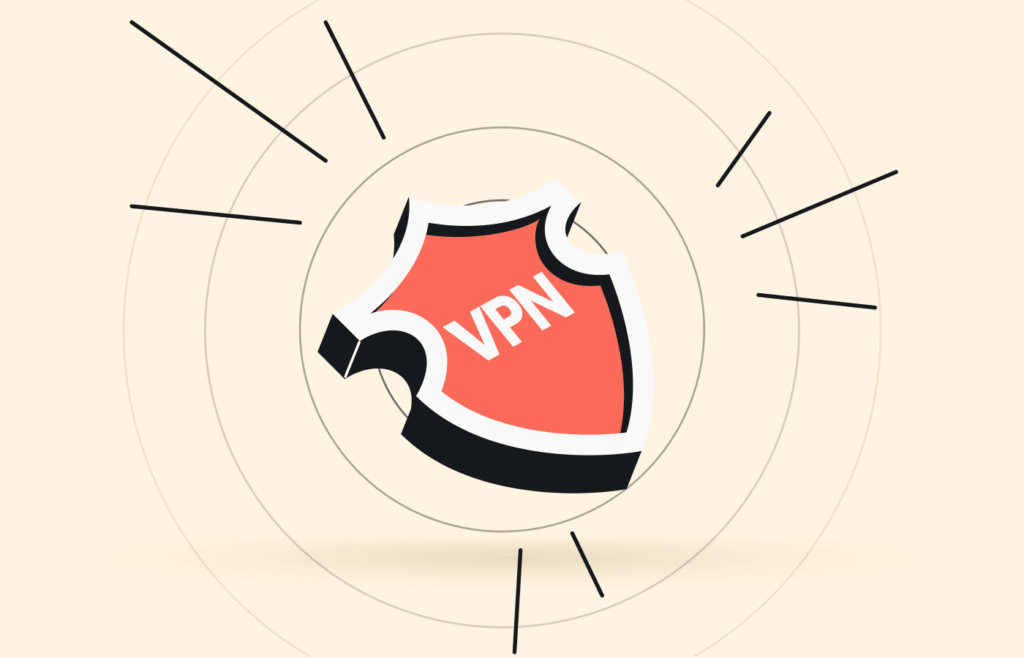
It depends on where you live. For example, most countries permit VPN usage and consider them legal. However, some countries like North Korea, Iraq, Turkey, and China consider VPNs illegal.
So, if you’re on a vacation or a work trip, you should acquaint yourself with the regulations around VPN usage.
Is downloading content with a VPN legal?
Downloading content without the owner’s permission is popular worldwide, but it’s largely illegal. In fact, European law strictly prohibits downloading copyrighted content.
Moreover, it is illegal to watch movies and TV shows on free platforms. So, it’s important to familiarize yourself with the laws in your current location before accessing free streaming sites.
Even with a VPN, you can still face consequences for illegally downloading copyrighted content. However, VPNs will obscure your online and physical locations, making it difficult to apprehend you.
UDP vs. TCP in streaming
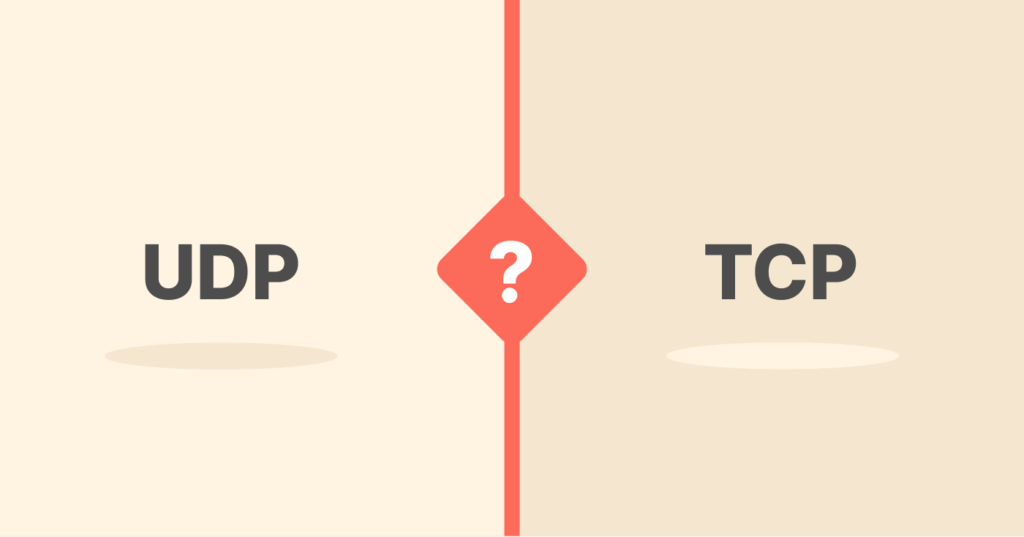
While streaming can use both transmission control protocol (TCP) and user datagram protocol (UDP), each has its specific use cases depending on the type of streaming.
Transmission control protocol (TCP)
TCP is a protocol that delivers data packets in the correct order and error-free. It is highly reliable as it even retransmits any lost packet.
Many streaming platforms rely on protocols such as HLS or MPEG-DASH, which operate over HTTP and use TCP to ensure reliable data delivery.
On-demand streaming uses TCP because it’s not extremely time-sensitive (minor delays are acceptable) and helps ensure high-quality playback. When data packets are lost during transmission, TCP will automatically retransmit them, ensuring the content arrives intact.
User datagram protocol (UDP)
UDP transmits data without ensuring the packets arrive in order or even confirm delivery. While it’s faster than TCP, it sacrifices reliability since it doesn’t retransmit lost data packets.
It is used in live streaming applications due to the need for low latency, where minor data loss is unnoticed and doesn’t significantly impact the experience.
UDP is preferred in live streams as they need to be as close to real-time as possible. Therefore, the occasional data loss is acceptable, since retransmitting lost data would add latency and potentially degrade the video experience.
Hybrid approaches
Modern live streaming protocols like Secure Reliable Transport (SRT) and Google’s QUIC combine features of both TCP and UDP to balance between low latency and reliable delivery. This hybrid approach delivers UDP’s speed and TCP’s reliability, enabling fast and dependable data transmission.
Future of streaming
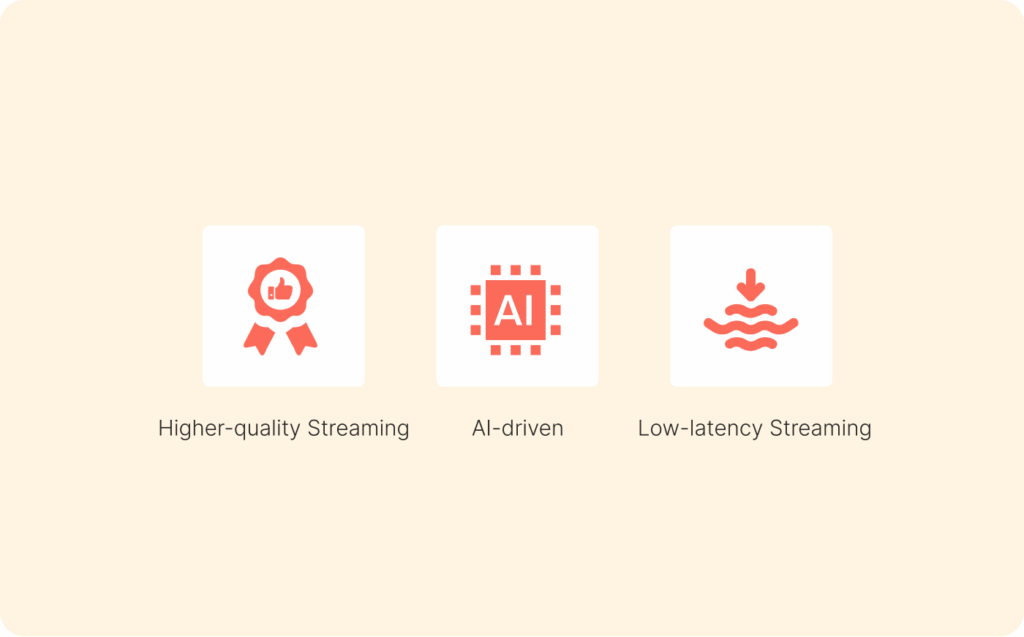
Technological advancements and changing consumer habits will shape the future of streaming. Key trends include:
- Higher-quality streaming: 5G connectivity and 8K resolutions will make ultra-high-quality more accessible.
- AI-driven personalization: AI will enhance user satisfaction by delivering more precise content recommendations.
- Low-latency streaming: Technologies like SRT and WebRTC facilitate real-time streaming, which is essential for live events.
- Live commerce: Streaming integrates e-commerce, enabling in-stream purchases.
- Global reach: AI-driven language translation will make content more accessible worldwide.
- Sustainability: Future technology will focus on energy efficiency to reduce environmental impact.
FAQs
First, you have to download a streaming app on your device, like Netflix, Disney+ or Amazon Prime Video. Then, create an account, pay your subscription, and start enjoying your favorite content. If the site is blocked in your region, you can use a VPN to unblock it.
No, you can stream on any internet-enabled device, including smart TVs. A streaming device, such as Roku, Amazon Fire Stick, Apple TV, or DirecTV Gemini device can also enable you to stream on your regular TV.
Yes, you need stable and high-speed internet to stream smoothly. Thankfully, many devices today are internet-enabled, enabling you to stream from your smartphone, tablet, smart TV, and more.
Not necessarily. You can use legitimate free streaming sites like Tubi to watch a range of movies and TV shows, though the content is often dated and features are limited. So, use premium platforms like Netflix for a richer viewing experience. Thankfully, on-demand streaming is nowadays affordable – it’s live TV that tends to drive up the cost.
